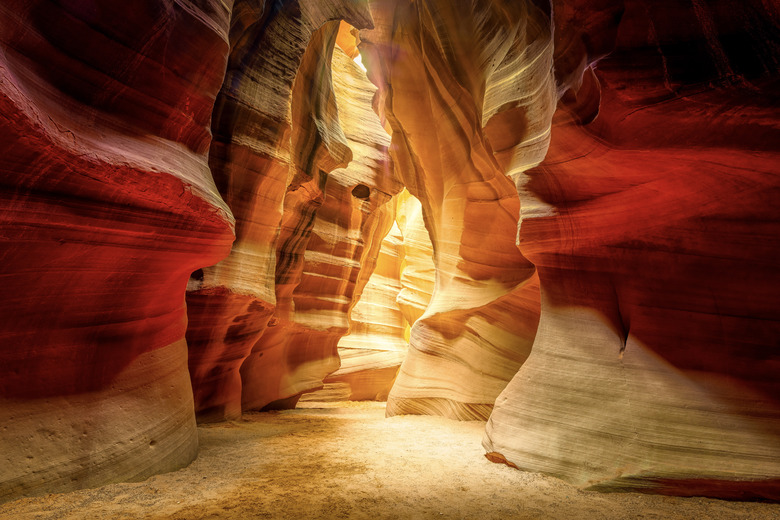The Difference Between Weathering & Erosion
Weathering and erosion are processes by which rocks are broken down and moved from their original location. The difference between weathering and erosion is based on whether a rock's location has changed: Weathering degrades a rock without moving it, while erosion carries rocks and soil away from their original locations. Weathering often leads to erosion by causing rocks to break down into smaller pieces, which erosive forces can then move away.
TL;DR (Too Long; Didn't Read)
Weathering and erosion are sometimes use interchangeably, but they're different. **Weathering** breaks large rocks into smaller pieces, while **erosion** moves those pieces away from the original rock.
Erosion vs. Weathering
Erosion vs. Weathering
The main difference between weathering and erosion lies in where the process takes place. Weathering degrades a rock without changing its location. Erosion, on the other hand, causes rocks – or particles of rock – to be carried away from their original locations and deposited elsewhere. Weathering often leads to erosion, breaking down the rock into small pieces that are easier for wind and water to carry away.
Wind abrasion is an example of a process that includes both weathering and erosion. Wind picks up small pieces of rock and blows them against larger stones, causing small particles of the larger formations to break off – this is weathering. The same wind picks up these particles and takes them away from the rock they broke off of – this is erosion.
Types of Weathering
Types of Weathering
There are two distinct types of weathering, which alter and degrade rock in different ways. Physical weathering breaks down a rock's physical structure. For example, in cold environments water that gets into holes in rock and freezes will cause those holes to expand and eventually crack and split the rock.
The same process may be caused by salt buildup or growing tree roots. Another form of physical weathering occurs when wind or water causes rocks to rub against each other, smoothing their surfaces.
Chemical weathering changes the chemical structure of rock, causing it to become softer or more brittle. For example, iron in a rock might react with oxygen to form easily degradable rust, or acids in rainwater may remove calcium from limestone and marble. Chemical weathering often precedes physical weathering, making rocks more vulnerable to forces like wind and rain.
Types of Erosion
Types of Erosion
Different types of erosion are usually differentiated by the force that carries rock, stone or soil away from its location. Water is the most common force that causes erosion. Rivers wear down and carry away rock and soil along their banks. The Grand Canyon was formed from millions of years of this sort of erosion. Similar erosion occurs in the ocean, where moving water and waves degrade and carry away particles of coastline rock.
Wind erosion can only occur on smaller particles of ash, dust and rock, but it can still move large quantities of these particles from their original locations and create impressive formations, such as sand dunes.
Erosion by ice is rare in most parts of the world, but ice can move much larger rocks than most other erosive forces. Ice may carry huge boulders miles away from their original locations.
Erosion vs. Mass Wasting
Erosion vs. Mass Wasting
Mass wasting is a specific type of erosion that is caused by gravity. Mass wasting occurs when soil or rocks are carried away – not by wind or water – but by falling or sliding downwards.
A rockslide or landslide is a common example of mass wasting, as a large quantity of loose rock or soil rolls or slides down a slope. Rock falls occur when loose rock splits off from high cliffs. Mass wasting may also cause physical weathering by causing rocks to shatter upon hitting the ground or causing rocks to rub against each other while rolling and sliding.
Cite This Article
MLA
Zamboni, Jon. "The Difference Between Weathering & Erosion" sciencing.com, https://www.sciencing.com/difference-between-weathering-erosion-8212886/. 30 September 2021.
APA
Zamboni, Jon. (2021, September 30). The Difference Between Weathering & Erosion. sciencing.com. Retrieved from https://www.sciencing.com/difference-between-weathering-erosion-8212886/
Chicago
Zamboni, Jon. The Difference Between Weathering & Erosion last modified August 30, 2022. https://www.sciencing.com/difference-between-weathering-erosion-8212886/
